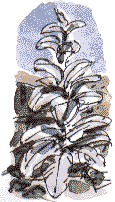Towers of Mullein
Wild West Yorkshire nature diary, Sunday 6th June 1999
 ON THE BALLAST of a railway siding Mullein is putting up tall spires of greyish felty leaves, but its large yellow flowers have not appeared as yet. Grey foliage is usually an adaption to open sunny conditions. It gives this plant a Mediterranean look.
ON THE BALLAST of a railway siding Mullein is putting up tall spires of greyish felty leaves, but its large yellow flowers have not appeared as yet. Grey foliage is usually an adaption to open sunny conditions. It gives this plant a Mediterranean look.

 Oxford Ragwort, which has been in flower for some months, has Mediterranean origins. Railways were the way it spread throughout Britain, from its toe-hold growing on a wall in the Oxford Botanical Gardens. The feathery seed spread in the slipstream of locomotives. The plant is adept at colonising bare stoney ground, like this ballast, since its original home was the slopes of volcanoes in Italy.
Oxford Ragwort, which has been in flower for some months, has Mediterranean origins. Railways were the way it spread throughout Britain, from its toe-hold growing on a wall in the Oxford Botanical Gardens. The feathery seed spread in the slipstream of locomotives. The plant is adept at colonising bare stoney ground, like this ballast, since its original home was the slopes of volcanoes in Italy.
 Weld has its spikes of small greenish yellow flowers. Here it is growing near the site of an old dye works. It was once grown in Yorkshire to provide yellow dye.
Weld has its spikes of small greenish yellow flowers. Here it is growing near the site of an old dye works. It was once grown in Yorkshire to provide yellow dye.
Railway embankments have changed since the last days of steam, which I remember from my childhood. Sparks from steam locomotives caused repeated grass fires in cuttings which have since been taken over by dense scrub. My memories are that large stands of Rosebay Willowherb were a more common sight at that time.
 A female Sparrowhawk (the female is larger and browner than the male) swoops down over the house roofs into our back garden. It makes no strike and flies off along the field edge. Its progress is marked by the alarm calls of Blackbirds and by a variety of smaller birds suddenly bursting out of the back gardens and flying off over the field.
A female Sparrowhawk (the female is larger and browner than the male) swoops down over the house roofs into our back garden. It makes no strike and flies off along the field edge. Its progress is marked by the alarm calls of Blackbirds and by a variety of smaller birds suddenly bursting out of the back gardens and flying off over the field.
 A pair of Linnets rest on a telephone wire in front of a house. In size and silhouette they remind me of goldfinches, but they are not as heavily built.
A pair of Linnets rest on a telephone wire in front of a house. In size and silhouette they remind me of goldfinches, but they are not as heavily built.
Richard Bell,
wildlife illustrator
E-mail; 'richard@daelnet.co.uk'



 Next day
Previous day
Nature Diary
Wild West Yorkshire home page
Next day
Previous day
Nature Diary
Wild West Yorkshire home page
|
 ON THE BALLAST of a railway siding Mullein is putting up tall spires of greyish felty leaves, but its large yellow flowers have not appeared as yet. Grey foliage is usually an adaption to open sunny conditions. It gives this plant a Mediterranean look.
ON THE BALLAST of a railway siding Mullein is putting up tall spires of greyish felty leaves, but its large yellow flowers have not appeared as yet. Grey foliage is usually an adaption to open sunny conditions. It gives this plant a Mediterranean look.
 Oxford Ragwort, which has been in flower for some months, has Mediterranean origins. Railways were the way it spread throughout Britain, from its toe-hold growing on a wall in the Oxford Botanical Gardens. The feathery seed spread in the slipstream of locomotives. The plant is adept at colonising bare stoney ground, like this ballast, since its original home was the slopes of volcanoes in Italy.
Oxford Ragwort, which has been in flower for some months, has Mediterranean origins. Railways were the way it spread throughout Britain, from its toe-hold growing on a wall in the Oxford Botanical Gardens. The feathery seed spread in the slipstream of locomotives. The plant is adept at colonising bare stoney ground, like this ballast, since its original home was the slopes of volcanoes in Italy. Weld has its spikes of small greenish yellow flowers. Here it is growing near the site of an old dye works. It was once grown in Yorkshire to provide yellow dye.
Weld has its spikes of small greenish yellow flowers. Here it is growing near the site of an old dye works. It was once grown in Yorkshire to provide yellow dye. A female Sparrowhawk (the female is larger and browner than the male) swoops down over the house roofs into our back garden. It makes no strike and flies off along the field edge. Its progress is marked by the alarm calls of Blackbirds and by a variety of smaller birds suddenly bursting out of the back gardens and flying off over the field.
A female Sparrowhawk (the female is larger and browner than the male) swoops down over the house roofs into our back garden. It makes no strike and flies off along the field edge. Its progress is marked by the alarm calls of Blackbirds and by a variety of smaller birds suddenly bursting out of the back gardens and flying off over the field. A pair of Linnets rest on a telephone wire in front of a house. In size and silhouette they remind me of goldfinches, but they are not as heavily built.
A pair of Linnets rest on a telephone wire in front of a house. In size and silhouette they remind me of goldfinches, but they are not as heavily built.